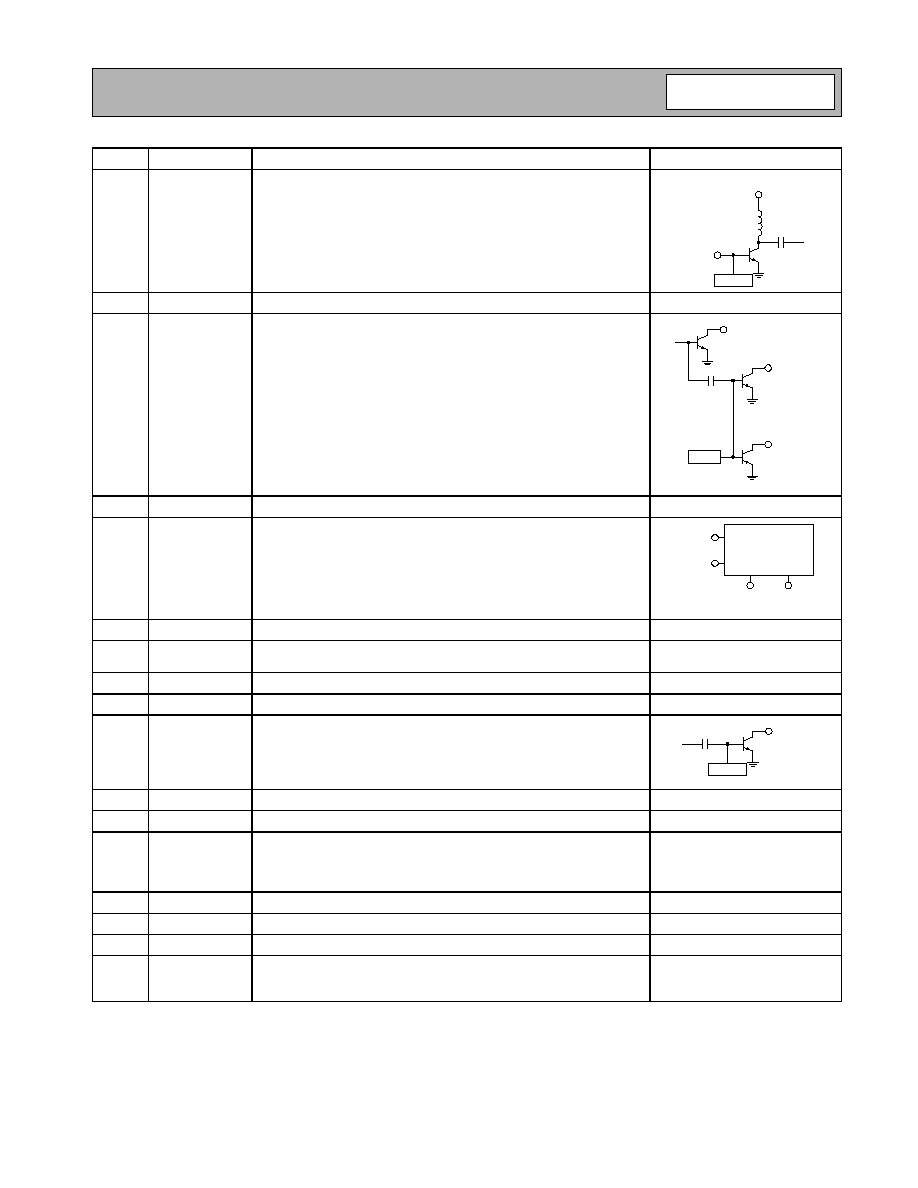
2-573
Product Description
Ordering Information
Typical Applications
Features
Functional Block Diagram
RF Micro Devices, Inc.
7628 Thorndike Road
Greensboro, NC 27409, USA
Tel (336) 664 1233
Fax (336) 664 0454
http://www.rfmd.com
Optimum Technology MatchingÆ Applied
Si BJT
GaAs MESFET
GaAs HBT
Si Bi-CMOS
SiGe HBT
Si CMOS
InGaP/HBT
GaN HEMT
SiGe Bi-CMOS
PWR SEN
BIAS GND1
RF IN
NC
PWR REF
VREG1
VREG2
BIAS GND 2
NC
RF OUT
RF OUT
RF OUT
NC
NC
VCC
VCC
16
15
14
13
5
6
7
8
9
10
11
12
4
3
2
1
Bias
RF5117
3V, 1.8GHz TO 2.8GHz
LINEAR POWER AMPLIFIER
∑ IEEE802.11B WLAN Applications
∑ IEEE802.11G WLAN Applications
∑ 2.5GHz ISM Band Applications
∑ Commercial and Consumer Systems
∑ Portable Battery-Powered Equipment
∑ Spread-Spectrum and MMDS Systems
The RF5117 is a linear, medium-power, high-efficiency
amplifier IC designed specifically for battery-powered
WLAN applications such as PC cards, mini PCI, and
compact flash applications. The device is manufactured
on an advanced Gallium Arsenide Heterojunction Bipolar
Transistor (HBT) process, and has been designed for use
as the final RF amplifier in 2.5GHz WLAN and other
spread-spectrum transmitters. The device is provided in a
3mmx3mm, 16-pin, leadless chip carrier with a backside
ground. The RF5117 is designed to maintain linearity
over a wide range of supply voltage and power output.
∑ Single 3.3V Power Supply
∑ +30dBm Saturated Output Power
∑ 26dB Small Signal Gain
∑ High Linearity
∑ 1800MHz to 2800MHz Frequency Range
∑ +17dBm P
O
, 11G, <3% EVM
RF5117
3V, 1.8GHz to 2.8GHz Linear Power Amplifier
RF5117 PCBA
Fully Assembled Evaluation Board
0
Rev A7 041007
1.50 TYP
2 PLCS
0.15 C B
-B-
1.37 TYP
2 PLCS
0.15 C B
2 PLCS
0.15 C A
-A-
3.00 SQ.
2.75 SQ.
2 PLCS
0.15 C A
1.00
0.85
0.05
0.01
0.80
0.65
0.05 C
12∞
MAX
-C-
SEATING
PLANE
Shaded lead is pin 1.
Dimensions in mm.
C A B
0.10 M
0.30
0.18
0.60
0.24
TYP
0.50
0.55
0.30
1.65
1.35
SQ.
0.23
0.13
4 PLCS
0.45
0.00
4 PLCS
Package Style: QFN, 16-Pin, 3x3

2-574
RF5117
Rev A7 041007
Absolute Maximum Ratings
Parameter
Rating
Unit
Supply Voltage
-0.5 to +6.0
V
DC
Power Control Voltage (V
REG
)
-0.5 to 3.5
V
DC Supply Current
600
mA
Input RF Power
+10
dBm
Operating Ambient Temperature
-40 to +85
∞C
Storage Temperature
-40 to +150
∞C
Moisture sensitivity
JEDEC Level 3
Parameter
Specification
Unit
Condition
Min.
Typ.
Max.
Overall
T=25 ∞C, V
CC
=3.0V, V
REG
=2.7V,
Freq=2450MHz, circuit per evaluation board
schematic.
Frequency Range
1800 to 2800
MHz
Maximum Linear Output Power
With 802.11B modulation (11Mbit/s) and
meeting 802.11B spectral mask.
VCC=3.0V
22
dBm
VCC=5.0V
27
dBm
Linear Efficiency
25
%
Error Vector Magnitude (EVM)
2.5
%
P
O
=17dBm, EVM increases over 11g,
54MBPS signal input
Small Signal Gain
24
26
28.5
dB
P
IN
=-7dBm
Reverse Isolation
30
dB
Second Harmonic
-35
dBc
802.11B Adjacent Channel
Power
-38
-32
dBc
P
OUT
=21dBm, V
CC
=3.0V
Alternate Channel Power
-56
-52
dBc
P
OUT
=21dBm, V
CC
=3.0V
Isolation
35
45
dB
In "OFF" state, P
IN
=-5.0dBm
Input Impedance
50
With external matching
Input VSWR
2:1
With external matching
Power Down
V
REG
"ON"
2.1
2.7
3.0
V
Voltage supplied to control input; device is
"ON"
V
REG
"OFF"
0
0.5
V
Voltage supplied to control input; device is
"OFF"
Power Supply
Operating Voltage
3.0 to 5.0
V
Current Consumption
500
mA
At max output power
200
220
mA
P
OUT
=21dBm, V
CC
=3.0V
110
mA
Idle current, V
CC
=3.0V, V
REG
=2.7V
V
REG
Current (Total)
5
10
mA
V
CC
=3.0V
10
15
mA
V
CC
=5.0V
Caution! ESD sensitive device.
RF Micro Devices believes the furnished information is correct and accurate
at the time of this printing. However, RF Micro Devices reserves the right to
make changes to its products without notice. RF Micro Devices does not
assume responsibility for the use of the described product(s).
Refer to "Handling of PSOP and PSSOP Products"
on page 16-15 for special handling information.

2-575
RF5117
Rev A7 041007
Pin
Function
Description
Interface Schematic
1
RF IN
RF input. Matching network with DC block required, see evaluation
board schematic for details.
2
BIAS GND1
Ground for first stage bias circuit. Not connected.
See pin 5.
3
PWR SEN
The PWR SEN and PWR REF pins can be used in conjunction with an
external feedback path to provide an RF power control function for the
RF5117. The power control function is based on sampling the RF drive
to the final stage of the RF5117.
4
PWR REF
Same as pin 3.
See pin 3.
5
VREG1
This pin requires a regulated supply to maintain nominal bias current.
6
VREG2
Same as pin 5.
See pin 5.
7
BIAS GND2
Ground for second stage bias circuit. For best performance connect to
ground with a 10nH inductor.
See pin 5.
8
NC
Not connected.
9
NC
Not connected.
10
RF OUT
RF output and bias for the output stage. The power supply for the out-
put transistor needs to be supplied to this pin. This can be done
through a quarter-wave length microstrip line that is RF grounded at the
other end, or through an RF inductor that supports the required DC cur-
rents.
11
RF OUT
Same as pin 10.
See pin 10.
12
RF OUT
Same as pin 10.
See pin 10.
13
VCC
Interstage match and bias for first stage output. Connect interstage
matching capacitor to this pad with a short trace. Connect low-fre-
quency bypass capacitors to this pin with a long trace. See evaluation
board layout for details.
See pin 1.
14
VCC
Same as pin 13.
See pin 1.
15
NC
Not connected.
16
NC
Not connected.
Pkg
Base
GND
Ground connection. The backside of the package should be connected
to the ground plane through a short path, i.e., vias under the device will
be required.
RF IN
VCC
Bond Wire
Inductance
BIAS
RF OUT
PWR SEN
PWR REF
BIAS
BIAS
VREG1
VREG2
BIAS
GND1
BIAS
GND2
RF OUT
BIAS

2-576
RF5117
Rev A7 041007
Theory of Operation and Application Information
The RF5117 is a two-stage device with a nominal gain of 26dB in the 2.4GHz to 2.5GHz ISM band. The RF5117 is
designed primarily for IEEE802.11B/11G WLAN applications where the available supply voltage and current are limited.
This amplifier will operate to (and below) the lowest expected voltage made available by a typical PCMCIA slot in a lap-
top PC, and will maintain required linearity at decreased supply voltages.
The RF5117 requires only a single positive supply of 3.0V nominal (or greater) to operate to full specifications. Power
control is provided through two bias control input pins (V
REG1
and V
REG2
), but in most applications these are tied
together and used as a single control input.
There is some external matching on the input and output of the part, thus allowing the part to be used in other applica-
tions outside the 2.4GHz to 2.5GHz ISM band (such as MMDS). Both the input and the output of the device need a
series DC-blocking capacitor. In some cases, a capacitor used as a matching component can also serve as the blocking
cap. The circuit used on the evaluation board is optimized for 3.0V nominal applications.
For best results, the PA circuit layout from the evaluation board should be copied as closely as possible, particularly the
ground layout and ground vias. Other configurations may also work, but the design process is much easier and quicker if
the layout is copied from the RF5117 evaluation board. Gerber files of our designs can be provided upon request.
The RF5117 is not a difficult part to implement, but care in circuit layout and component selection is always advisable
when designing circuits to operate at 2.5GHz. The most critical passive components in the circuit are the input, inter-
stage and output matching components (C1, C5, C7, and C11). In these cases, high-Q capacitors suitable for RF appli-
cations are used on our evaluation board (a BOM is available on request). High-Q parts are not required in every design,
but it is very strongly recommended that the original design be implemented with the same or similar parts used on our
evaluation board. Then, less costly components can be substituted in their place, making it easy to test the impact of
cheaper components on performance. General RFMD experience has indicated that the slightly higher cost of better
quality passive components is more than offset by the significant improvements in production yields in large-volume
manufacturing. Using less costly components will typically result in a 1 to 2dB degradation in gain.
The interstage matching capacitor, C11, along with the combined inductance of the internal bond wire, the short length
of circuit board trace, and the parasitic inductance of this capacitor, tunes the peak of the small-signal gain response.
The trace length between C11 and pins 13 and 14 should be kept as short as possible.
In practice, V
CC
and the supply for the output stage bias will be tied to the same supply. It is important to isolate C11 from
other RF and low-frequency bypass capacitors on this supply line. This can be accomplished using a suitably long trans-
mission line which is RF shorted on the other end. Ideally the length of this line will be a quarter wavelength, but it only
needs to be long enough so that the effects of other supply bypass capacitors on the interstage match are minimized. If
board space is a concern, this isolation can also be accomplished with an RF choke inductor or ferrite bead. Additionally,
a higher-value capacitor than shown on the application schematic can be used if bypass capacitors must be closer. A
Smith Chart can be used to provide initial guidance for value selection and parts placement. Be aware of the self-reso-
nant frequency (SRF) of higher-valued capacitors. The SRF must be above the frequency of operation.
The output matching caps are C5 and C7. These are tuned along with the 50
transmission line segments TL1 and TL2,
as shown on the evaluation board schematic. These segments should be duplicated as closely as possible. Due to vari-
ations in FR-4 characteristics and PCB manufacturer process variations, some benefit will be obtained from small adjust-
ments to these transmission line lengths when the evaluation board layout is duplicated on another design. Prior to full
rate manufacturing, the board layout of early prototypes should include some additional exposed ground areas around
C5 and C7 to optimize this part of the circuit. In order to reduce component count, the output can also be tuned with a
single capacitor. A Smith Chart can help determine the desired value and transmission line length, which can be similarly
adjusted on the board prior to production. This will result in a slightly lower-bandwidth and more sensitive match, but in
most applications the bandwidth is still sufficient.

2-577
RF5117
Rev A7 041007
Power sensing is implemented with the PWR SEN and PWR REF lines. The outputs of these pins are transistor collec-
tors and need to be pulled up to the supply through a resistor. PWR REF provides an output current proportional to the
output stage bias current, and PWR SEN provides an output current proportional to the total (RF and bias) current of the
output stage. The pull-up resistors convert these currents to voltages, and the voltage difference between these two pins
is proportional to the RF current. See the graph, "V
REF
-V
SENSE
versus P
OUT
", for the response of this signal. This differ-
ence signal can be fed to a power control circuit elsewhere in the end product, or it can be processed at the PA with addi-
tional circuitry and used to adjust the V
REG
voltage(s) to implement automatic level control. Contact RFMD Sales or
Applications Engineering for additional data and guidance in using this feature.
The RF5117 has primarily been characterized with a voltage on V
REG1
and V
REG2
of 2.7VDC. However, the RF5117 will
operate from a wide range of control voltages. If you prefer to use a control voltage that is significantly different than
2.7VDC, contact RFMD Sales or Applications Engineering for additional data and guidance.




